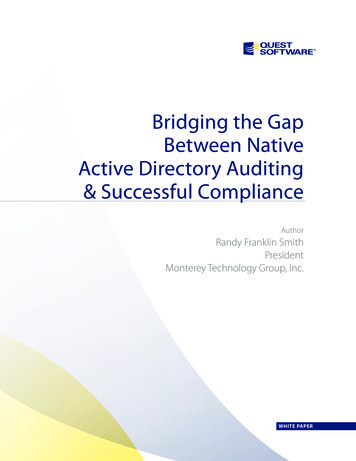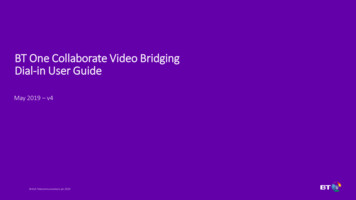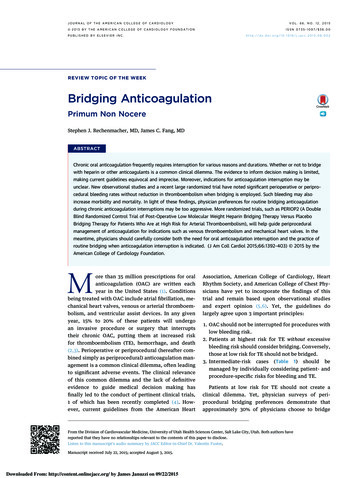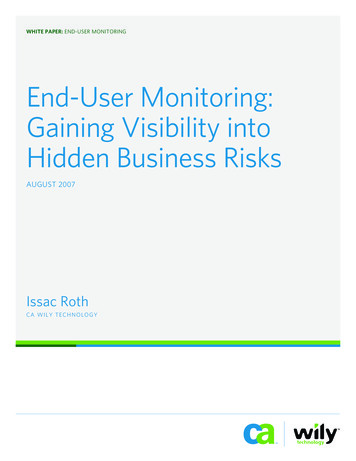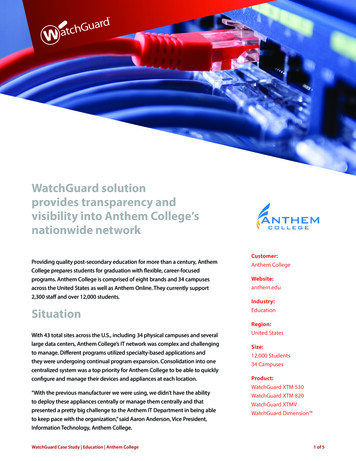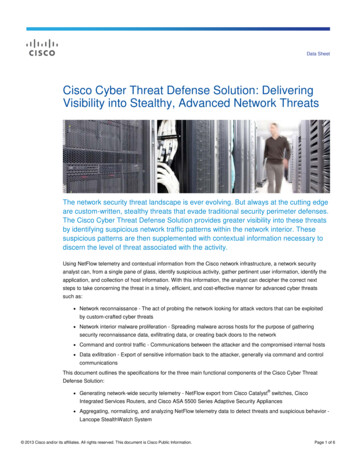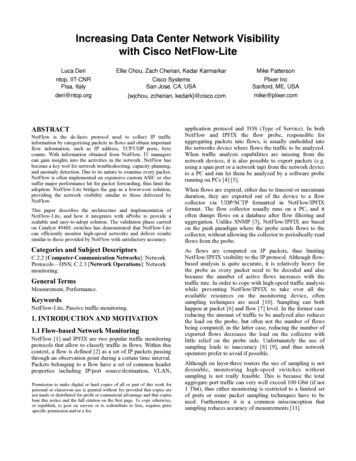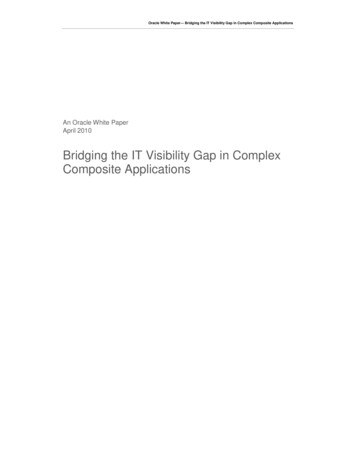
Transcription
Oracle White Paper— Bridging the IT Visibility Gap in Complex Composite ApplicationsAn Oracle White PaperApril 2010Bridging the IT Visibility Gap in ComplexComposite Applications
Oracle White Paper— Bridging the IT Visibility Gap in Complex Composite ApplicationsDisclaimerThe following is intended to outline our general product direction. It is intended for informationpurposes only, and may not be incorporated into any contract. It is not a commitment to deliverany material, code, or functionality, and should not be relied upon in making purchasingdecisions. The development, release, and timing of any features or functionality described forOracle’s products remains at the sole discretion of Oracle.
Oracle White Paper— Bridging the IT Visibility Gap in Complex Composite ApplicationsIntroduction . 4A History of Application Performance Management . 6A New Application Landscape . 7The Need for Composite Application Management . 8Composite Application Management in Oracle Enterprise Manager 10Conclusion . 13
Oracle White Paper— Bridging the IT Visibility Gap in Complex Composite ApplicationsINTRODUCTIONAs more and more IT shops deploy multitier middleware platforms and frameworks for the delivery ofbusiness-critical application services, they are expecting to garner the benefits of the service-orientedarchitecture (SOA) or composite application development approach: agility, flexibility, productivity,and extensibility. Typically, these benefits are delivered to application developers by the frameworkvendors, using proprietary or standards-based protocols. This flexibility for users usually results incomplex multitier environments, and the responsibility of managing this complexity has been assumedby developers and IT staff.Figure 1: Expected benefits of a composite application or service-oriented application approachImplementing composite applications or SOA is expected to align IT with the business and quicklyadjust to change as competitive pressures arise, as illustrated in Figure 1. However, the legacyapplication management products currently supporting these critical applications are increasinglykeeping these organizations from achieving these benefits. With the broad acceptance of Simple ObjectAccess Protocol (SOAP) and Representational State Transfer (REST), composite applications arefurther extended, especially because they allow the application logic to be further subdivided ordelivered by external environments.Traditional application performance management (APM) products provide deep visibility into theperformance of an enterprise application’s code components, but these tools fail to correlate the codeand code component performance with the performance of the application services delivered by thesecomplex composite applications. For example, an application implemented with a portal framework ontop of an application server delivers specific application services to end users, who are represented onthe portal pages by tab and page flow combinations.Although a traditional APM solution generally enables an IT organization to pull metrics on theunderlying code supporting an enterprise application, it typically doesn’t allow the IT organization toset a performance metric on that particular application service or business function, such as theaccount balance query, and then provide correlation down to the code components supporting that4
Oracle White Paper— Bridging the IT Visibility Gap in Complex Composite Applicationsservice. In n-tier composite applications, this correlation from the application services to the codewould provide IT organizations the ability to both diagnose and optimize the performance of theirapplications on a service-by-service basis. This is critical, because one application service on a particularportal page may be performing fine while another application service may be underperforming, yetthey are leveraging shared application components.The composite applications of the early part of this decade leveraged a relatively simple and staticarchitecture, generally a database with an application server and a graphical user interface. Today’scomposite applications are significantly more complex and dynamic. A typical SOA enterpriseapplication today might leverage a Java Enterprise Edition (Java EE)-based application server with aportal engine, a Service Bus, a Business Process Execution Language (BPEL) engine, and perhaps analternative integration framework to connect to a legacy back end. Each of these applicationcomponents is, in its own right, an application, and with a SOA-based application, the components arebound to change on a regular basis. Additionally, the shared-services code components constitutingeach of these application components (such as entity beans, JavaServer Pages, and portlets) supportmultiple application services, possibly across multiple applications.Using traditional APM products to correlate an application service with the underlying shared-servicescode components enabling that service has become all but impossible. This correlation is critical,however; the very purpose of an enterprise application is to provide business services, and if a problemwith the performance or availability of a particular application service supported by a compositeapplication cannot quickly be triaged, the value of the application will soon be overcome by the cost ofoutages, poor performance, and general maintenance chaos associated with supporting the application.Additionally, IT organizations need a dependable means of performing impact analysis. For example,before a planned change is made, IT operations must be able to identify all application processes,application components, systems, and so on, that will be affected by the change. This adds significantvalue only with the necessary context to bridge that gap (the “IT visibility gap”) between applicationservices and components.Today’s composite applications require a new management approach that dynamically correlatesapplication services with the shared code components supporting those services. Although astandalone APM approach will suffice for relatively simple Java EE applications, APM alone hasbecome obsolete for managing SOA and other complex composite applications.This white paper describes why a Composite Application Management approach is critical to providingenterprises the hierarchical visibility necessary to effectively manage today’s composite applications. Itexplains why this approach makes it possible to automate the instrumentation and dashboard creation,thus simplifying and commoditizing APM tasks that were once extremely time-consuming.Additionally, it illustrates that with today’s increasingly complex, multitier composite applicationarchitectures, enterprises must stop investing in legacy APM approaches and start investing inComposite Application Management solutions that encompass capabilities traditionally associated withAPM solutions while providing those capabilities in an automated and scalable fashion.5
Oracle White Paper— Bridging the IT Visibility Gap in Complex Composite ApplicationsA HISTORY OF APPLICATION PERFORMANCE MANAGEMENTFigure 2: Evolution of J2EE applicationsDuring the 1990s, most enterprises developed their mission-critical applications by using objectoriented programming languages such as C . Managing these applications did not generally presentmuch of a challenge; because the IT development teams managing them typically built the entireapplications, they could easily develop a tool that had visibility across whole applications.In the late 1990s, the application server market took off, with BEA WebLogic, IBM WebSphere andother application server platforms gaining significant ground. These application server platformsprovided much of the plumbing required to build a scalable enterprise application, leaving IT shops toinvest in the business logic and differentiating capability that provided the most value.Although the emergence of the application server market substantially accelerated applicationdevelopment schedules, it also made managing production applications a little more challenging. Forthe first time, a big portion of application code was not written by the IT organization developing theapplication, necessitating a management translation layer from the application server vendor’s code tothe application services provided by the application. A new breed of companies emerged inapproximately the year 2000 to address this need, providing manual byte-code instrumentationpackages that enabled IT architects, operations teams, and developers to drill down into the underlyingJava virtual machines (JVMs) within the application servers containing the business logic and pull outperformance data on the code (see Figure 2). These vendor tools typically instrument everything withinan application infrastructure and then require professional consultants from the companies toreconfigure the instrumentation and build custom dashboards, bringing the monitoring overhead downto a reasonable level and correlating the code-based metrics with the services provided by themonitored application. As long as the application architectures were not terribly complex, this solutionworked fairly well, providing enterprises much more visibility into their application performance thanthey had had without these tools.6
Oracle White Paper— Bridging the IT Visibility Gap in Complex Composite ApplicationsA NEW APPLICATION LANDSCAPEIn the early part of this decade, many CIOs began to express concern that they could not measure thereturn on their IT investments. Of course, businesses overspent on software and technology in the late1990s, and CIOs began to demand that their development teams and software vendors demonstratefinancial return. In 2002 Mercury Interactive Corporation (now part of Hewlett-Packard Company, orHP) recognized this opportunity and launched a new product suite based on a concept it calledbusiness technology optimization (BTO). Essentially, BTO meant providing CIOs and other high-levelIT executives with financial visibility into the performance of their application investments to ensurethat IT was aligning with the business.BTO tracked key performance indicators (KPIs), service-level agreements (SLAs), and other high-levelmetrics that spanned application investments but typically did not look into the applications. IBMCorporation; Computer Associates, Inc.; and HP soon followed with their own BTO-like offerings. Inthe meantime, BMC Software led the charge with business service management (BSM), which was builtto help IT organizations understand the business relationships between their application services andthe IT value these services delivered. BSM was based on automating IT service management (ITSM)processes, the heart of the Information Technology Infrastructure Library (ITIL). However, neitherBTO nor BSM provides the contextual relationship between an application’s services and the codecomponents enabling those services.Figure 3 shows the challenges posed by the IT visibility gap.Figure 3: The IT visibility gap must be overcome to achieve BTO, BSM, and other essential IT service management processes.Without this context, IT organizations deploying complex composite applications cannot effectivelyalign IT with the business, leveraging the tools and processes in which they have so heavily invested.The IT visibility gap has emerged as a result of the move toward shared application components,7
Oracle White Paper— Bridging the IT Visibility Gap in Complex Composite Applicationswhich, by design, hide the relationships between components in multiple layers of abstraction. With allthe benefits expected from SOA, new application management challenges have arisen.In the early 2000s, with the emergence of the application server market and the deployment of firstgeneration composite applications, all an enterprise needed in order to effectively manage its compositeapplications and application investments was a good APM solution and perhaps a BTO solution. By2005, however, the leading middleware platform vendors, such as IBM, BEA Systems, and Oracle,started to introduce specialized engines on top of their application server platforms, which providedsignificantly more capability to enterprises looking to build rich applications. Portal frameworks such asIBM WebSphere Portal and BEA WebLogic Portal dealt with the front-end functions of human-tomachine Web interfaces. Integration frameworks dealt with integration into back-end systems such aslegacy mainframe applications. Even more recently, SOA frameworks such as ESBs and BPEL enginesenabled the delivery of Web services and the rapid introduction of new services into an applicationwithout necessitating a wholesale change to the application architecture.In theory, the net effect of all of these middleware enhancements enables an IT team to quickly build asophisticated enterprise application and constantly roll out new services for the application withouthaving to rewrite key application components. Although building a rich and highly sophisticatedapplication has become much easier with these n-tier middleware components, managing theapplication has become much more complex.Specifically, as the middleware environments have continued to become more sophisticated, they havecreated a management gap between the management of the resources (APM) and the management ofthe business services (BTO). Today metrics have become a commodity. Most application servers spitout Java Management Extensions (JMX) data, making code-level performance visibility easy. Withcomplex composite applications, however, the importance of understanding the specific, unique, anddynamic associations between the application services and the shared code components that supportthose services has superseded the importance of having metrics on either the code or the applicationservices.THE NEED FOR COMPOSITE APPLICATION MANAGEMENTThe greatest challenge with managing these complex composite applications is gaining the necessaryvisibility to enable IT to perform its essential functions: incident and problem management, changeand release management, capacity management, availability management, service-level management,and configuration management.Figure 4 illustrates how three major factors—layers of abstraction, specialized expertise, and constantchange—contribute to the IT visibility gap.8
Oracle White Paper— Bridging the IT Visibility Gap in Complex Composite ApplicationsFigure 4: The problem—complex composite applications without visibilityAs mentioned earlier, the various middleware technologies and off-the-shelf code componentsorganizations have invested in are hiding the key relationships between business functions. This ismost apparent once the application development team hands off the enterprise application to thestaging and production operations teams. The tools for building these complex applications are notbuilt for the monitoring, testing, and ongoing management requirements of IT operations.Most important, traditional APM and system management tools have no way to correlate applicationprovided services with the underlying code components supporting those services, because the toolsfocus on breaking open the JVM and collecting and displaying metrics at the code level without thebusiness context. Unfortunately, IT must then manually link the relationships together and builddashboards to illustrate the relationships between the code-based metrics and the application services.Of course, all of this requires detailed knowledge of all the different code components, middlewaretechnologies, and relationships between applications. Worse, the manually linked relationships quicklybecome obsolete as the applications change.The pace of application change today is measured in days or weeks, whereas the typical time foranalyzing a performance problem by using a traditional APM solution is measured in weeks or months.This makes for a formula that simply doesn’t work. It creates a very painful and expensive gap in theway composite applications are managed. In many cases, the gains achieved in the development oftoday’s composite applications are often tossed away during the deployment and management phasesof projects.Figure 5 illustrates a shopping cart application in which three business functions are used by thebusiness service: search, quote, and order. The search function can be leveraged by an employeeplanning to purchase polo shirts for loyal customers, as illustrated by the red line. The quote functionmay be triggered by one of the company’s distributors looking to generate a quote for an upcomingindirect order via a reseller channel, depicted by the blue line. Note that the path taken leverages one or9
Oracle White Paper— Bridging the IT Visibility Gap in Complex Composite Applicationsmore shared application components. Finally, the order function, shown by the black line, represents acustomer order directly from the shopping cart application.Figure 5: The importance of contextFigure 5 shows that, depending on the context of the request, various business functions leverage oneor more shared application components—taking different paths—when delivering services to endusers.Without understanding the relationships between the application components and the services beingoffered (“context”), how can IT effectively align its actions with the priorities of the business? Howdoes it know what to monitor, how much to monitor, and how to interpret the metrics? How can ITeffectively prepare for a downtime window when it does not know what other services may be affectedby the change? What about capacity management or measurement of service levels? How aboutpinpointing the root cause of a performance bottleneck?Referring to Figure 5, imagine a situation in which one of the company’s distributors or resellerscannot receive quotes from the shopping cart application but other business functions being served bythe same shared application components work fine. Determining the root cause of the probleminvolves determining the specific code paths and associations between the services on that reseller’sWeb site and the portal, integration, workflow, and J2EE code components.To make it even more challenging, complex composite applications are constantly changing, along withthe upstream and downstream relationships between components.COMPOSITE APPLICATION MANAGEMENT IN ORACLE ENTERPRISE MANAGER10
Oracle White Paper— Bridging the IT Visibility Gap in Complex Composite ApplicationsFigure 6: Bridging the IT visibility gapOracle can bridge the IT visibility gap by delivering Oracle Enterprise Manager, which correlates theservices provided by the applications with the underlying code components supporting those services.In other words, Composite Application Management provides the context required to effectivelymanage the performance of complex composite applications.Leveraging Composite Application Management, Oracle Enterprise Manager can intelligentlydetermine the appropriate monitoring points, deploy the required agents, and dynamically display rolebased dashboards with relevant metrics within the context of the application services being delivered.Because of the inability to capture the context, no one else in the systems management space has beenable to attack this management challenge from the top down.Figure 7: The Oracle Enterprise Manager modeling processOracle is able to accomplish this by first building a topological model of the application architecture—mapping the business functions down to the code com
Corporation; Computer Associates, Inc.; and HP soon followed with their own BTO-like offerings. In the meantime, BMC Software led the charge with business service management (BSM), which was built to help IT organizations understand the business relationships between their applic

